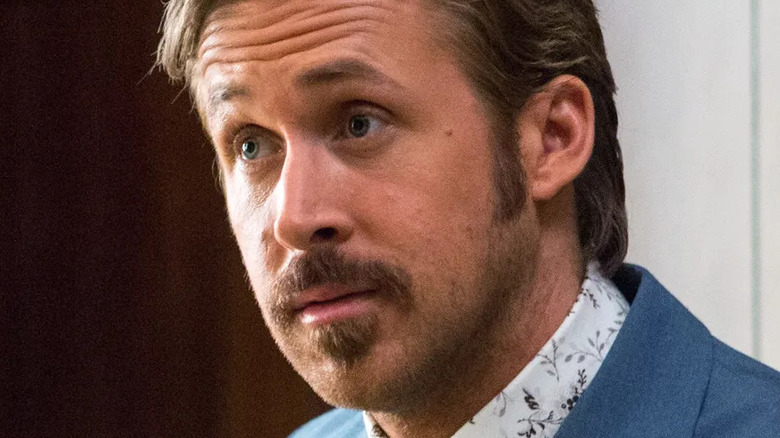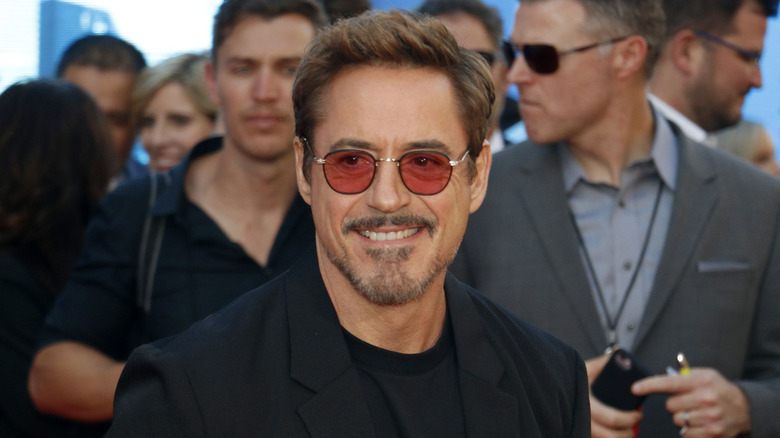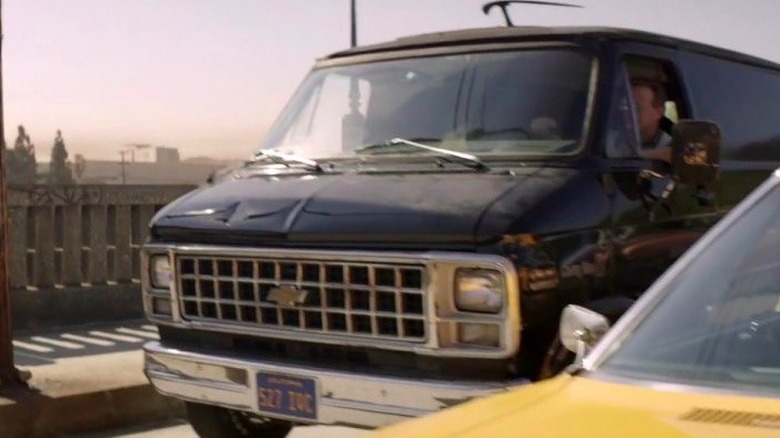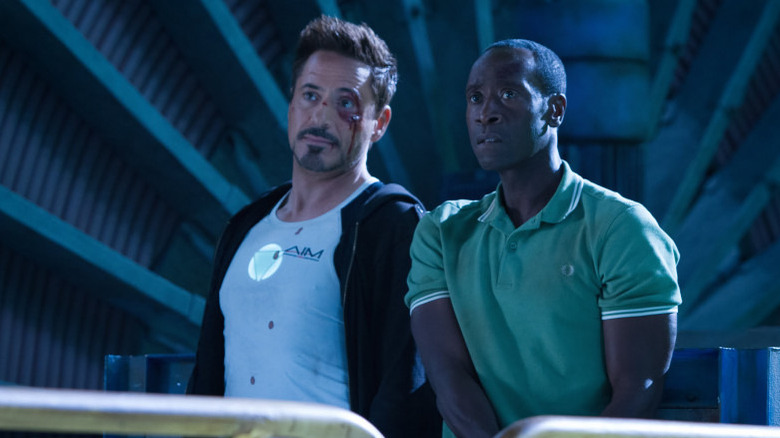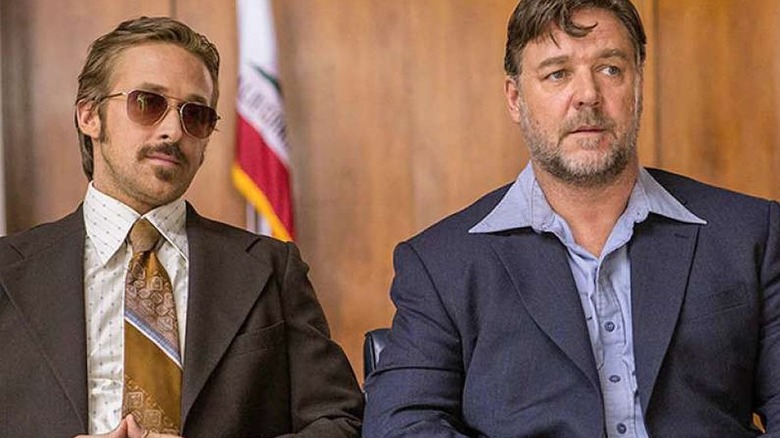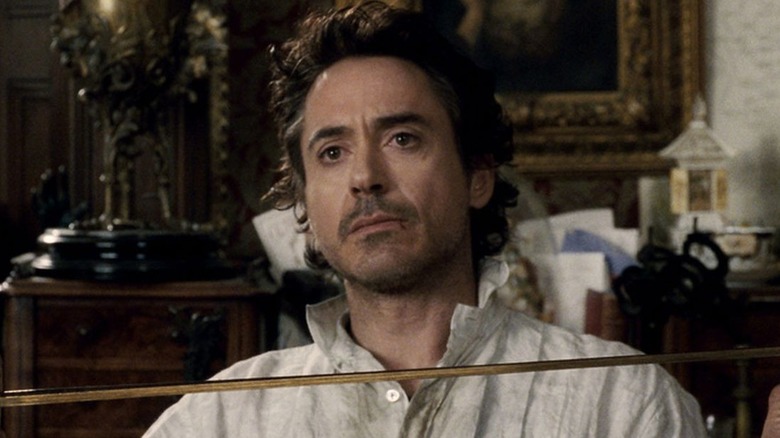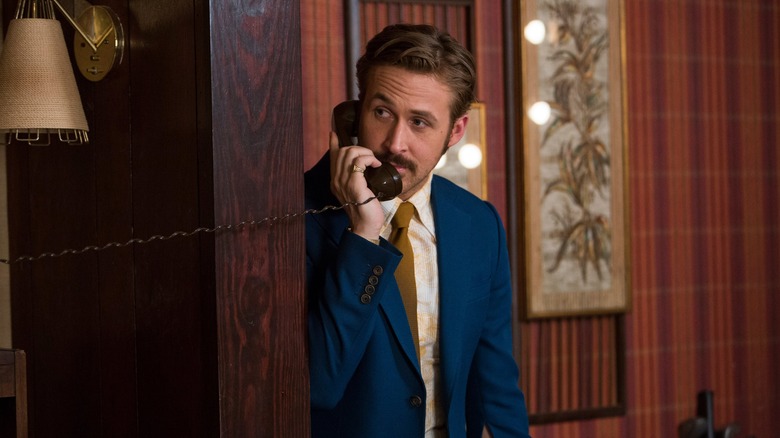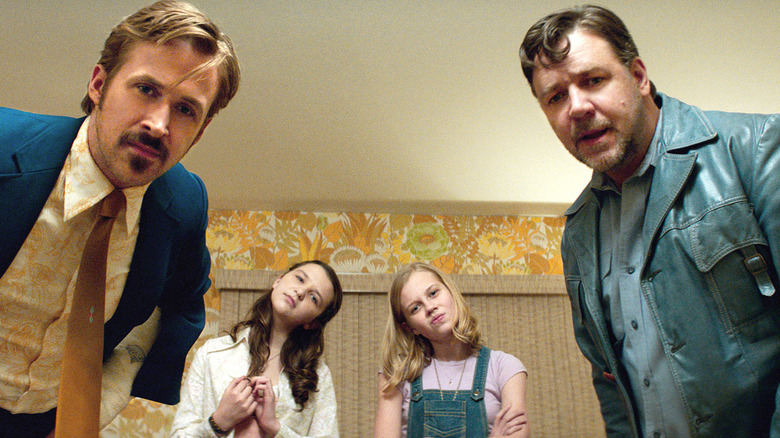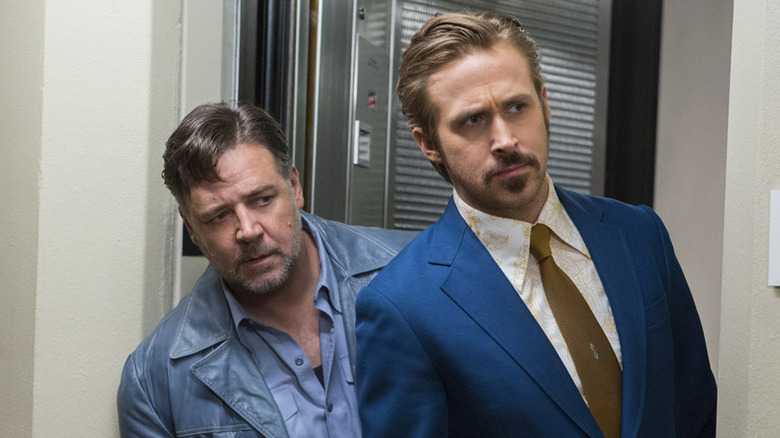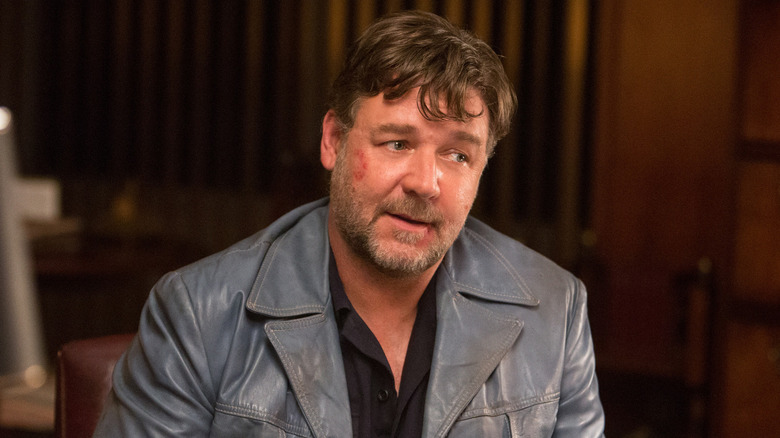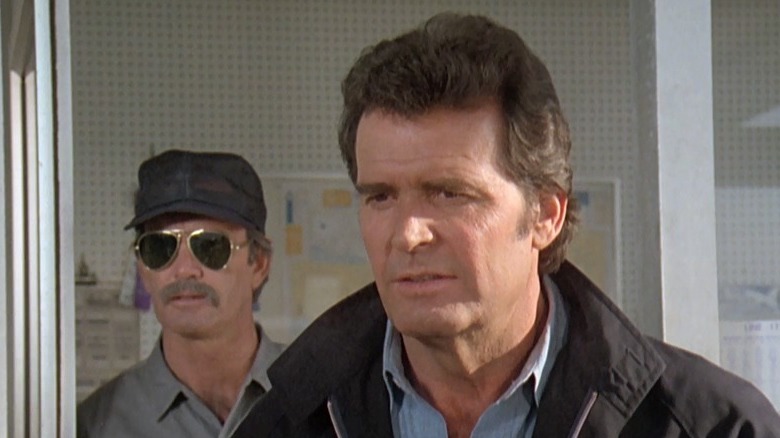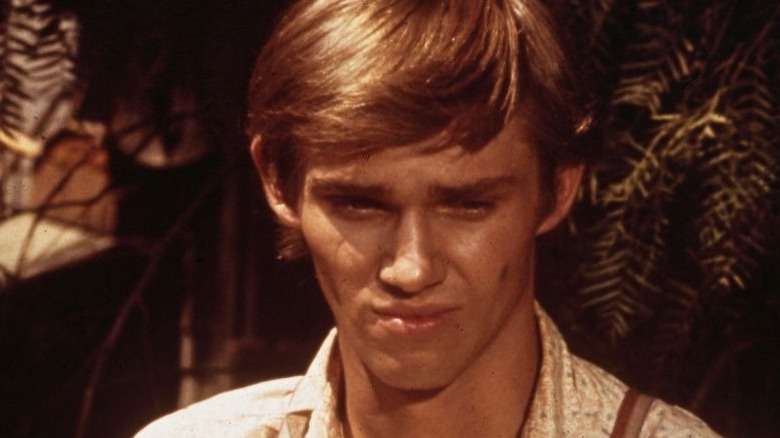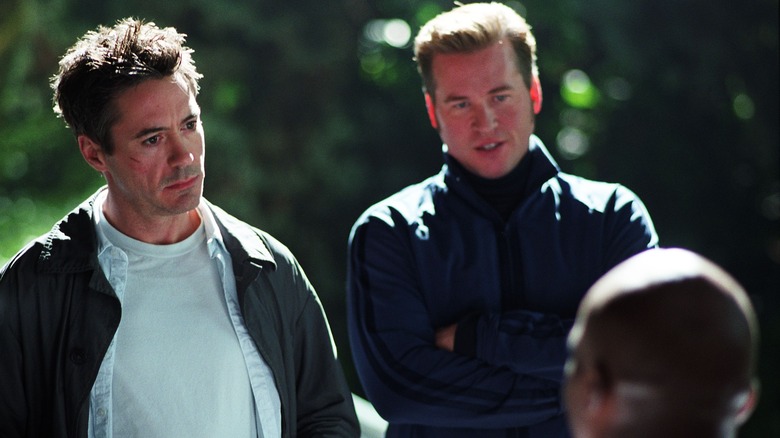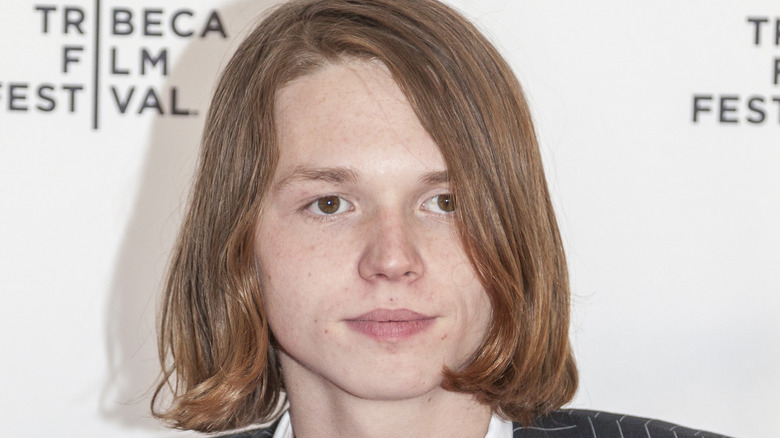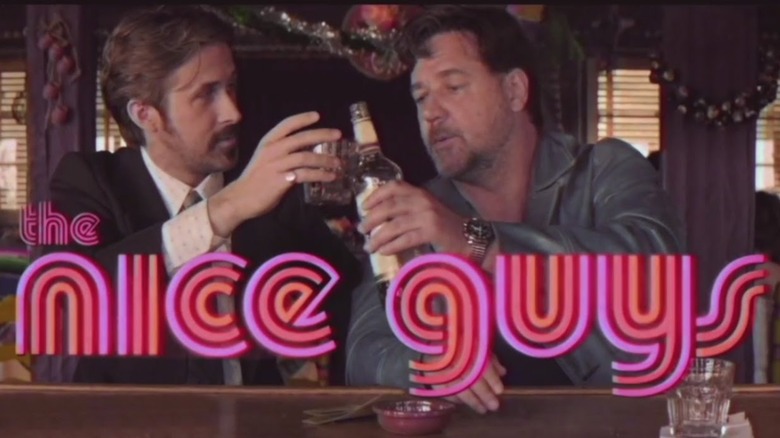The Untold Truth Of The Nice Guys
Among the annals of buddy cop films, "The Nice Guys" might just be the best. It's a film that harkens back to the noir aesthetic of classic detective movies, overlaid with the comedic tone found in police movies of the '80s and '90s. Directed and co-written by Shane Black, it feels almost like a spiritual successor to Black's previous films like "Lethal Weapon" and "Kiss Kiss Bang Bang," combining a great script with two notable starring actors.
Like those aforementioned movies, the premise of "The Nice Guys" revolves around a humorously mismatched pair of detectives (Ryan Gosling and Russell Crowe) trying to find a missing girl (Margaret Qualley) in 1970s Los Angeles. With its retro style, nonstop laughs, and pitch-perfect writing, "The Nice Guys" was a major critical success. On the flip side, the movie performed extremely poorly at the box office, earning $62.8 million on a budget of $50 million (per Box Office Mojo).
Financial failures aside, "The Nice Guys" continues to enjoy a successful post-release life on various streaming services, quickly achieving cult status since its release in 2016. For all the popularity "The Nice Guys" is slowly securing, there may be a few things about the movie you might have missed upon your initial viewing. Here are some of the most interesting details and behind-the-scenes facts about "The Nice Guys."
An uncredited Robert Downey Jr. plays a dead guy
One of the main plot points early in "The Nice Guys" is the efforts of both March (Ryan Gosling) and Healy (Russell Crowe) to find adult film producer Sid Shattuck. Venturing into the Hollywood Hills, the two detectives attend a party thrown at Shattuck's luxurious house, with March accidentally stumbling upon Shattuck's badly mangled corpse in the woods nearby. Due to extensive injuries on his face, it can be hard to make out Shattuck's face clearly. But upon closer inspection, you can see that the face belongs to none other than Robert Downey Jr., who appears in a brief uncredited cameo as the deceased adult filmmaker.
This might seem like a random appearance from the prominent Marvel Cinematic Universe star, but Downey and "The Nice Guys" director Shane Black had previously worked together in "Kiss Kiss Bang Bang" and "Iron Man 3." The former film is actually credited with reigniting Downey's career in the mid-2000s after a series of major personal and professional setbacks, paving the way for him to become a Marvel superstar in "Iron Man."
Apparently, Downey and Black have a close enough working relationship for Downey to make a cameo in "The Nice Guys," no matter how small the role and difficult to notice the cameo actually is.
The black van that hits Blueface can be spotted later
One of the more random deus ex machina moments in "The Nice Guys" occurs when the villainous hit man known only as Blueface (Beau Knapp) is struck and killed by a large black van as he prepares to kill Amelia (Margaret Qualley). After Blueface is knocked down, the driver of the van skids to a stop, loudly curses, and then speeds away before Amelia can reach him. The scene is very sudden and out of nowhere, and is seemingly just a random hit-and-run, but the van and the driver do pop up again later in the film.
Shortly after John Boy (Matt Bomer) launches his assault on March's house in an attempt to kill Amelia, a demoralized March, Healy, and Holly (Angourie Rice) are seen in a taxi sitting in heavy traffic. As the camera pans over the gridlocked cars next to them, you can actually see the same black van that killed Blueface right next to the film's main trio.
Given that the van struck Blueface at night and sped away quickly afterwards, it can be hard to notice at first that this is the same van stopped next to the protagonists' taxi. However, if you take a closer look, you can see that not only is it the same exact make and model of the van (a period-inaccurate 1980 Chevrolet) that killed Blueface, but it even has the same dent on the front hood from where the van crashed into the gangster earlier in the film.
A recycled bit of dialogue from Iron Man 3
As mentioned previously, "The Nice Guys" was directed and co-written by Shane Black, who'd previously also written and directed "Iron Man 3." As different as the two films are from one another, there are some similarities between Black's movies that signify the films were directed by the same individual. In particular, a bit of Black's dialogue in "Iron Man 3" is reused in "The Nice Guys."
When Healy and March enter The Flight Lounge bar, they begin interrogating the bartender to see if Amelia had recently been there. The bartender is reluctant to provide any information at first, leading March to quip that if he tells the two detectives what they want to know, then "he'll "stop doing it," while pointing at Healy. Confused, the bartender asks, "Doing what?" Healy then grabs the bartender's tie and slams his head into the bar immediately afterwards.
This bit of dialogue is taken almost word for word from "Iron Man 3," albeit in slightly different circumstances. Shortly after James Rhodes (Don Cheadle) and Tony Stark (Robert Downey Jr.) capture Trevor Slattery, Stark tells Slattery, "You tell him where Pepper is and he'll stop doing it." Like the bartender in "The Nice Guys," Slattery replies, "Doing what?" with Rhodey then pressing the burning hot end of his pistol into the side of Slattery's earlobe.
The screenplay was originally envisioned as a TV pilot
Like so many scripts that are produced for the entertainment industry, "The Nice Guys" went through a prolonged genesis that saw it undergo several major changes over the years. Initially, Shane Black revealed that he and co-writer Anthony Bagarozzi envisioned the story in a modern setting. After the script failed to entice potential financial backers, Black and Bagarozzi rewrote the script as a television pilot instead.
This pilot version of "The Nice Guys" floated around to several television networks in the mid-2000s, including CBS, but ultimately, as Black told IndieWire, no network expressed interest in developing the pilot into an entire series.
After a few more years shopping another version of "The Nice Guys" around Hollywood — once again reworked as a film script — Black eventually got the attention of Ryan Gosling, who agreed to star in the film. It was actually a relief of sorts for Black to see the story emerge as a feature instead of a TV show: "You spend more money, you get better lighting, and you get more time and attention. You get to tell a more quality story," he said. "Also, tonally, TV tends to homogenize."
Sherlock Holmes helped secure the movie's '70s setting
As discussed above, the original script for "The Nice Guys" took place in a contemporary setting. After one version of it failed to get picked up as a TV pilot, co-writers Shane Black and Anthony Bagarozzi once again reworked the script into a film screenplay. According to a Box Office Pro interview with producer Joel Silver, it was at this point that Bagarozzi brought up the idea of moving the script from its modern setting to the 1970s.
Silver said that he was initially uncertain about such a drastic change, especially because of the public's lack of interest in historical films. "I was a little dubious because I knew people at that moment were very concerned with period movies," said Silver. "Will they track? Can we get them into the theater?" However, Silver eventually relented based on the success of 2009's "Sherlock Holmes," which turned a serious profit at the box office, grossing over $520 million against a $90 million budget (via Box Office Mojo).
Based on the financial success of "Sherlock Holmes," Silver agreed with Bagarozzi's suggestion to change the film's time period, approving the film's production after Black concluded his work on "Iron Man 3."
Ryan Gosling essentially saved the film
After years spent shopping the film around Hollywood trying to attract potential producers, the saving grace for "The Nice Guys" came when the script found its way to Ryan Gosling's doorstep. According to Shane Black's interview with IndieWire, Gosling read the script and instantly found it intriguing. "In 2014 we put it out one last time and Ryan Gosling looked at it and his agent said, 'This is the sort of thing Ryan's looking for,'" said Black.
After Gosling signed on, eventual co-star Russell Crowe voiced his interest in appearing in "The Nice Guys" as well, based almost entirely on his desire to work with Gosling. As Black related, "Within three days [after Gosling agreed to star in the film] Russell Crowe said 'I like it, and if Ryan's doing it, I'll do it.' After 13 years it just popped into place in three days."
According to Gosling and Crowe, much of their enthusiasm for the film came out of their mutual desire to appear in a film opposite one another. "I'm such a big Shane Black fan and working with Russ — he's a hero of mine. I always hoped we would work together," Gosling told Variety. As Gosling said in an interview with Collider, "the movie just immediately became so funny" when he read the script with Crowe in mind as Healy, given how radically different the role was from any Crowe had appeared in previously.
The title is meant to be sarcastic
The title of "The Nice Guys" is only elaborated upon near the very end of the film, when March presents a custom-made flier advertising the Nice Guys Detective Agency to Healy. While the title might seem like a clue to the movie's ending, it was actually devised as a clever joke meant to "con" viewers, tricking them into believing the movie was focused on two likable characters.
"The Nice Guys" co-writer Anthony Bagarozzi told Variety, "You know they're two not-very-nice guys. One breaks arms for a living and the other cons old ladies out of money." As Bagarozzi saw it, it was almost a deliberate challenge created by Bagarozzi and Black that saw them writing a story centered around two unlikable protagonists, and trying to win audiences over with their portrayal in the film. "It was literally the two worst people that we could think of and then trying to make that fun," added Bagarozzi.
A TV series spin-off was in the works
Just as "The Nice Guys" was briefly reimagined as a TV pilot before it finally went into production as a theatrical project, the critical success of the movie ironically led to the possibility of a TV series spin-off loosely based on the film's premise. However, this potential series would have seen a dramatic shift in terms of its main characters.
According to Deadline, primetime TV network Fox approved a spin-off script of "The Nice Guys" with an entirely female focus, tentatively titled "The Nice Girls." The script was to be written by Michael Diliberti, writer of the 2011 film "30 Minutes or Less," and was to be produced by Silver Pictures Television, Lionsgate TV, and 20th TV.
News of "The Nice Girls" spin-off was first reported in 2017, but apart from the fact that it would feature a modern setting, no other ties to "The Nice Guys" film were made clear, nor were any details provided about potential stars who might have been attached to the project. Since then, there have been no public updates in regards to the script's progress, or whether Fox has expressed any interest in expanding the script into a full-fledged television show.
Russell Crowe says he'd love to make a sequel
Russell Crowe has made it a habit of signing onto films he only feels an artistic desire to partake in. No matter how substantial the paycheck, Crowe has said on programs like The Howard Stern Show that he only likes making movies that challenge him creatively. On Stern's show, he also said that he rarely signs onto sequels out of fear that they will never be as good as the original movie. However, Crowe did voice his enthusiasm about making a sequel for "The Nice Guys," saying it's one of the few movies he'd be interested in doing.
"There's many, many characters that I've played that I would love to see where they're at now," Crowe said on the show. Specifically, he pointed out his lead characters from "The Nice Guys" and "L.A. Confidential" — a 1997 retro noir film that saw Crowe star as another burly enforcer-type detective — as two characters he'd love to play again.
In interviews promoting "The Nice Guys," Shane Black has also discussed the potential for a sequel — although he has also said that, because of the movie's lukewarm financial success, it wasn't very likely "The Nice Guys II" will ever see the light of day. "We had all kinds of ideas. The problem is it didn't do that well at the box office," said Black in an interview with Fandango. "If someone decided that it were enough of a cult hit to justify that, I'd be on it."
The Rockford Files references
One of the clearest stylistic influences on "The Nice Guys" can be seen in the James Garner-led detective series, "The Rockford Files," which ran on NBC from 1974 to 1980. Due to the similar historical timeframe of both "The Nice Guys" and "The Rockford Files," "The Nice Guys" makes several small references to the famous detective series. One of the more subtle of these is the visual design of Holland March's flier that appears in the yellow pages, advertising his detective agency.
Comparing March's flier with that of Jim Rockford's, viewers are able to see right away that March's ad is an almost exact copy of Rockford's yellow pages ad, right down to the similar font and the pose both men hold in the hand-drawn portraits that appear on the fliers.
Aside from the obvious similarities between the two detectives' fliers, "The Nice Guys" also contains another humorous nod to "The Rockford Files," centered around an unexpected hiding place that Rockford uses for his gun. In "The Nice Guys," March is shown keeping his pistol in a cookie jar. This is famously the exact same hiding spot Jim Rockford uses for his own sidearm as well.
John Boy has the same mole as his TV counterpart
"The Rockford Files" isn't the only reference "The Nice Guys" makes to a popular TV series of its era. One of the most explicit examples of this comes with the character of John Boy, Matt Bomer's cold-blooded but effective hit man who shares his name with a main character from the classic '70s TV show, "The Waltons." In the context of the show, the character of John-Boy is the oldest of the seven Walton children, played in the series by Richard Thomas.
Apart from their similar names, the two John Boys also have another key trait in common — that being a large mole on the side of their faces. Sharp-eyed viewers are sure to spot a large mole on the side of John Boy's right cheek in "The Nice Guys." In actuality, this looks to be about the same size of John-Boy's mole in "The Waltons," which is on the exact same part of the face as John Boy's mole in "The Nice Guys."
Evidently, Bomer's John Boy is either a big enough fan of the show to adopt the code name John-Boy as his criminal alias, or the name may be meant more ironically, due to the defining physical feature the two characters share.
A Kiss Kiss Bang Bang reference
After years working as a Hollywood screenwriter, penning scripts for buddy cop films like "Lethal Weapon," "The Last Boy Scout," and "Last Action Hero," Shane Black made his directorial debut with 2005's neo-noir comedy film, "Kiss Kiss Bang Bang." Like Black's previous work on "Lethal Weapon" and his later work on "The Nice Guys," "Kiss Kiss Bang Bang" focuses on an oddball pair of detectives, played by Val Kilmer and Robert Downey Jr.
The film earned almost entirely positive reviews from critics, leading to Downey's resurgence in the film industry, and also established Black as a talented filmmaker able to adapt his own scripts for the silver screen. While "Kiss Kiss Bang Bang" and "The Nice Guys" have plenty in common in terms of their similar plots and comedic tones, Black also included a few more subtle allusions to his directorial debut in "The Nice Guys" as well.
One of these references comes early in the film, when March is first introduced via his opening narration. As he drives through the night-lit streets of Los Angeles, he passes an adult theater advertising a movie called "Bang Bang Kiss Kiss" on its marquee — an obvious tip of the hat Black pays to the film that gave him his start as a director.
The actor who plays Chet is Val Kilmer's son
Another, more noticeable reference that "The Nice Guys" makes to its hard-boiled precursor, "Kiss Kiss Bang Bang," is the casting of one of the film's supporting characters. Chet, an enthusiastic film projectionist who actually ends up playing a crucial role at the climax of the movie, is played by none other than Jack Kilmer — the son of Val Kilmer, one of the two leading men in "Kiss Kiss Bang Bang," along with Robert Downey Jr.
"The Nice Guys" marks one of the younger Kilmer's first forays into mainstream acting after his career began in 2013. His feature film debut came in 2014's "Palo Alto," a project that he developed with director Gia Coppola. Helping Coppola with the script and partaking in occasional table readings, he impressed Coppola enough that the latter encouraged Kilmer to audition for Teddy, one of the movie's main characters.
Following "Palo Alto," Kilmer appeared in 2015's "The Stanford Prison Experiment" and "Len and Company," before landing a part in "The Nice Guys" — his fourth film, released when Kilmer was only 21 years old. More recently, he provided the narration for "Val," a documentary centered around his father.
The film was promoted with a '70s style trailer
To better promote "The Nice Guys," Warner Bros. released a "70s Retro Trailer" that was deliberately dated to look like a genuine film from the 1970s. With its neon-lit title treatment and period-accurate narration, the trailer truly felt like something out of the '70s. Included in the trailer was a funk-centric soundtrack, a few audio crackles, an "introducing" credit for star Kim Basinger, and an overall grainier quality that seemed to suggest the movie was shot on film rather than digital.
Uniquely, this is one of the few movies Warner Bros. has utilized such an outside-the-box promotion for. In 2014, the company used a similar tactic to promote the neo-noir crime film by Paul Thomas Anderson, "Inherent Vice," releasing an "Ultimate '70s Trailer" to hype up the movie's premiere. Interestingly, not only are "Inherent Vice" and "The Nice Guys" both set in the '70s, but the two movies also harken back to the genre and setting of classic noir films, injecting them with an added dose of comedy.
